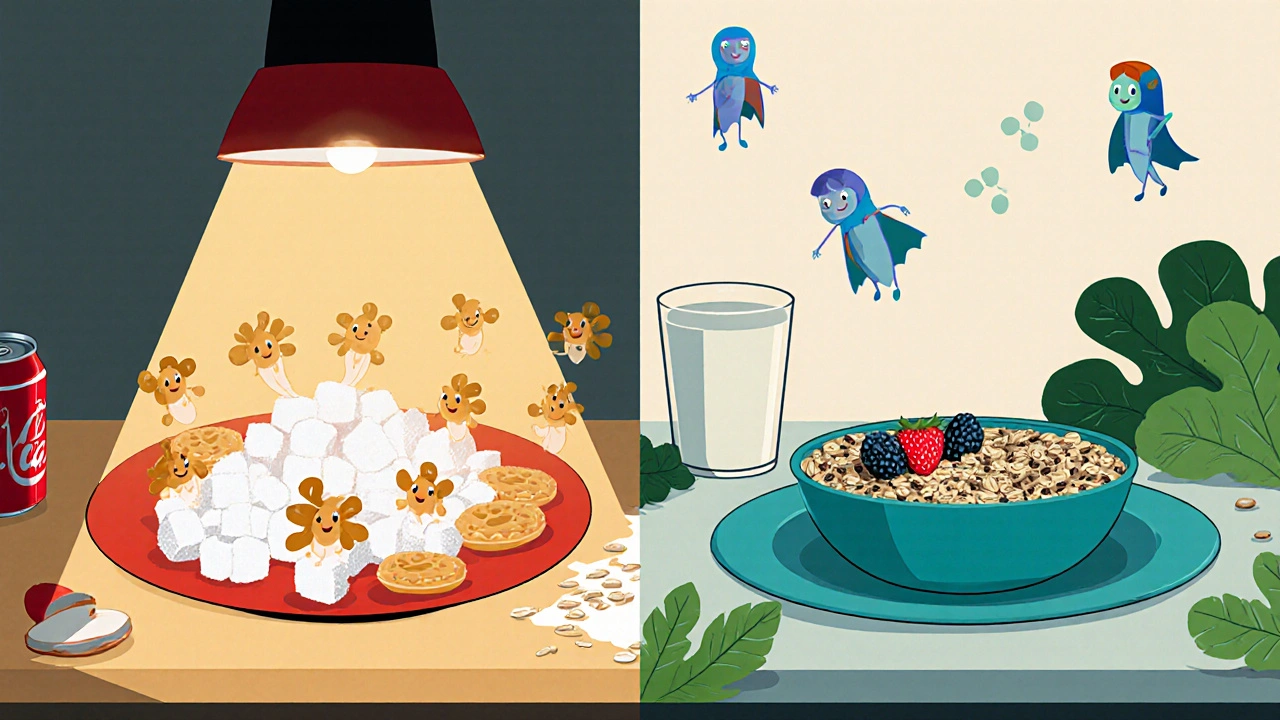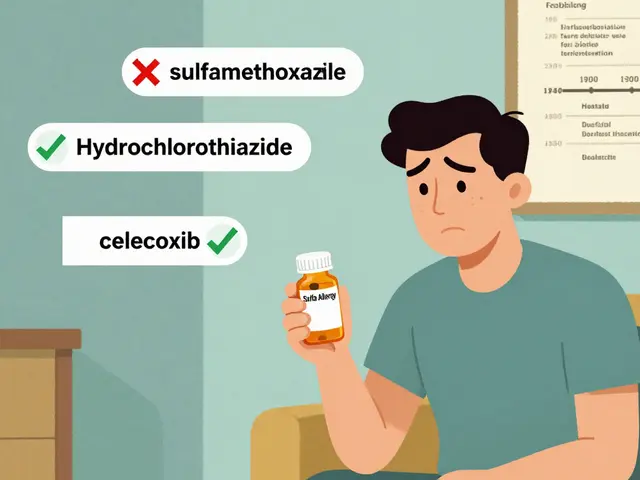Fungal Infection Risk Calculator
This tool assesses your risk of developing or worsening fungal infections based on dietary habits. The calculator uses guidelines from the article "How Diet Can Prevent and Treat Fungal Infections".
Fungal infections are illnesses caused by molds, yeasts, or other fungi that invade skin, nails, lungs, or the gut. Common culprits include Candida, Aspergillus, and dermatophytes that cause athlete’s foot. While prescription antifungals are the frontline treatment, research shows that what you eat can tip the balance between a harmless colonizer and an aggressive pathogen. In this guide we’ll explore how diet and fungal infections intersect, which foods help keep fungi at bay, and how to build meals that support a resilient immune system.
Why Your Plate Matters
Fungi thrive on sugar, moist environments, and weakened immunity. A diet high in refined carbs spikes blood glucose, creating a buffet for yeast and mold. At the same time, a fiber‑rich, nutrient‑dense menu fuels beneficial bacteria that compete with fungi for space and nutrients. The gut microbiome acts like a security team: when it’s diverse and balanced, it produces short‑chain fatty acids that lower gut pH, making it inhospitable for fungal overgrowth. In short, food choices can either starve pathogens or feed them.
How Sugar Fuels Fungal Growth
Every gram of glucose is a potential energy source for yeast. Studies from the University of California showed that Candida albicans doubles its growth rate when exposed to 5% glucose compared with 1% glucose. This is why people with uncontrolled diabetes or those who consume large amounts of sugary drinks often experience recurrent yeast infections. Reducing simple sugars-think soda, candy, pastries-cuts the fuel supply and slows fungal replication.
The Gut Microbiome Connection
The gut houses trillions of microbes, including bacteria that secrete antifungal compounds like lactic acid and bacteriocins. When antibiotics or a low‑fiber diet wipe out these allies, fungi get a chance to expand. A 2023 meta‑analysis of 12 clinical trials found that a diet high in prebiotic fibers (inulin, resistant starch) reduced Candida colony‑forming units by an average of 35% after four weeks. Feeding the good bacteria, therefore, indirectly suppresses fungi.
Key Dietary Patterns for Prevention
- Low‑glycemic approach: Choose whole grains, legumes, and non‑starchy vegetables that release glucose slowly.
- Anti‑inflammatory focus: Include omega‑3 rich foods (salmon, flaxseed) and colorful vegetables rich in polyphenols (berries, leafy greens).
- High‑fiber foundation: Aim for 25-35g of fiber daily from sources like oats, chia seeds, and artichokes.
- Fermented foods: Incorporate yogurt, kefir, sauerkraut, and kimchi to boost probiotic intake.

Foods to Limit or Avoid
Not every “healthy” food is fungus‑friendly. Here are the biggest offenders:
- Refined sugars - white sugar, high‑fructose corn syrup, honey (in large amounts).
- Alcohol - especially beer and sweet wines, which contain fermentable carbs.
- White flour products - white bread, pastries, and many snack foods.
- High‑lactose dairy - some people find that excess lactose feeds Candida.
- Mold‑prone foods - aged cheeses, dried fruits, and peanuts can introduce fungal spores.
Foods That Fight Fungal Overgrowth
| Food | Effect on Fungi | Why It Works |
|---|---|---|
| Garlic | Inhibits growth | Allicin has strong antifungal properties |
| Coconut oil | Disrupts cell walls | Medium‑chain fatty acids penetrate fungal membranes |
| Oregano oil | Broad‑spectrum antifungal | Carvacrol and thymol damage fungal enzymes |
| Green tea | Reduces colonization | Epigallocatechin gallate (EGCG) interferes with fungal biofilm |
| Fermented vegetables | Promotes competition | Live lactic‑acid bacteria lower gut pH |
Sample One‑Day Meal Plan
Putting the theory into practice is easier when you have a concrete plan. Below is a balanced day that follows the low‑glycemic, high‑fiber, antifungal blueprint.
- Breakfast: Overnight oats made with rolled oats, unsweetened almond milk, chia seeds, and a handful of blueberries. Top with a spoonful of unsweetened Greek yogurt and a sprinkle of cinnamon (cinnamon has mild antifungal activity).
- Mid‑morning snack: A small apple paired with 10g of raw, unsalted almonds.
- Lunch: Mixed greens salad with spinach, arugula, sliced cucumber, and roasted salmon. Dress with olive oil, lemon juice, and minced garlic. Add half a cup of sauerkraut on the side.
- Afternoon snack: Celery sticks dipped in 2tbsp of coconut oil‑based almond butter.
- Dinner: Stir‑fried broccoli, bell peppers, and shiitake mushrooms (in moderation) cooked in ginger‑garlic oil. Serve over quinoa and finish with a drizzle of tamari.
- Evening beverage: A cup of warm green tea with a slice of lemon.
Notice the absence of added sugars, the presence of probiotic‑rich sauerkraut, and plenty of fiber‑dense vegetables.
Supplements That Complement a Fungal‑Friendly Diet
While food is the foundation, a few targeted supplements can give extra support, especially during an active infection.
- Probiotic capsules containing Lactobacillus rhamnosus and Bifidobacterium bifidum - these strains have been shown to reduce Candida overgrowth.
- Oregano oil softgels (standardized to 5% carvacrol) - take 2capsules daily, but avoid long‑term use without a break.
- Garlic extract (aged, no odor) - 600mg twice daily can provide allicin without the strong smell.
- Beta‑glucan from oats or mushrooms - supports immune function and may help the body keep fungal spores in check.
Always discuss supplements with a healthcare professional, especially if you’re on prescription antifungals, as interactions can occur.
When Diet Alone Isn’t Enough
Even the best diet can’t fully eradicate a deep‑seated infection like onychomycosis (fungal nail infection) or invasive aspergillosis. Warning signs that you need medical help include:
- Persistent itching, redness, or swelling that lasts more than two weeks.
- Visible nail discoloration, thickening, or crumbling.
- Respiratory symptoms (cough, wheeze) combined with a history of mold exposure.
- Systemic signs such as fever, unexplained weight loss, or fatigue despite dietary changes.
In these cases, a clinician may prescribe oral azoles, topical agents, or even surgical debridement. Use diet as a preventive maintenance plan, not a substitute for prescribed therapy when the infection is established.
Quick Checklist for a Fungus‑Friendly Lifestyle
- Trim added sugars and refined carbs.
- Eat at least 30g of fiber daily from diverse plant sources.
- Include 1-2 servings of fermented foods each day.
- Use antifungal spices - garlic, oregano, cinnamon - liberally in cooking.
- Stay hydrated; aim for 2‑L water intake to keep mucosal surfaces moist but not overly wet.
- Maintain good skin hygiene; change socks and shoes daily.
- Consider a probiotic supplement during or after antibiotic courses.
Frequently Asked Questions
Can I completely cure a fungal infection with diet?
Diet can dramatically reduce the severity of mild yeast overgrowth and prevent recurrences, but established infections-especially in nails or lungs-usually need medication. Think of diet as a powerful ally, not a standalone cure.
How long does it take to see results after changing my diet?
Most people notice less itching or discharge within 2-4 weeks if they stick to a low‑sugar, high‑fiber plan. For nail infections, visible improvement can take 3-6 months because nails grow slowly.
Are there any foods that I should completely avoid if I have a candida infection?
Eliminate sweetened beverages, candy, pastries, white bread, and excess fruit juices. Limit cheese, mushrooms, and processed meats that can carry mold spores.
Do probiotics really work against fungal overgrowth?
Yes. Certain strains, especially Lactobacillus rhamnosus GG and Bifidobacterium lactis, produce lactic acid that lowers gut pH and directly inhibits Candida. Clinical trials report a 30‑40% reduction in yeast counts when these probiotics are taken for 8 weeks.
Is it safe to combine antifungal herbs with prescription medications?
Many herbs (like oregano oil) can increase the blood levels of azole drugs, leading to side effects. Always check with your doctor before adding strong antifungal herbs to your regimen.







Rohit Sridhar
17 October 2025 - 19:18 PM
I’ve found that swapping out sugary snacks for a handful of nuts makes a big difference.
When you cut back on refined carbs, the cravings tend to settle down on their own.
Adding a splash of apple cider vinegar to your salad dressing can help keep blood sugar stable throughout the day.
Probiotic-rich foods like kefir or sauerkraut flood your gut with friendly bacteria that out‑compete yeast.
Garlic and oregano aren’t just flavor boosters; their allicin and carvacrol actively hinder fungal cell walls.
Experiment with a low‑glycemic breakfast-think steel‑cut oats topped with cinnamon and a few berries.
Keep a water bottle handy; proper hydration flushes excess glucose through your kidneys.
If you love coffee, try brewing it black or with a dash of MCT oil instead of sugary syrups.
For a snack, spread almond butter on celery sticks and sprinkle with pumpkin seeds for crunch.
Remember that stress hormones can also feed fungi, so a quick walk or a few minutes of deep breathing helps.
Consistency is key; you’ll notice less itching and a clearer complexion after a couple of weeks.
Don’t forget to check ingredient labels for hidden sugars like maltitol or dextrose.
Incorporating a daily dose of omega‑3s from fish or chia seeds supports the immune system’s antifungal response.
If you’re on antibiotics, a short probiotic course can prevent the collateral damage that lets fungi flourish.
Stay patient, stay positive, and your diet will become a powerful ally against stubborn infections.
Sarah Hanson
18 October 2025 - 23:05 PM
Your overview of the low‑glycemic approach is most informative. However, the recommendations could benefit from more precise quantification of fiber intake, which is definitely essential. Also, consider includng a wider variety of prebiotic sources for a more robust microbial balance.
kendra mukhia
20 October 2025 - 02:52 AM
Oh, so you think simply swapping sugar for quinoa will magically erase years of fungal battles? Let me tell you, the reality is far messier. You need to overhaul your entire food pattern, not just sprinkle a few “healthy” ingredients here and there. Otherwise you’re just feeding the fungus a masquerade dinner.
Bethany Torkelson
21 October 2025 - 06:38 AM
Cut the carbs now-your gut won’t thank you for procrastinating. Immediate change is the only way to starve the fungus.
Grace Hada
22 October 2025 - 10:25 AM
Fungi are opportunistic; your diet is the battlefield. Choose your weapons wisely.
alex montana
23 October 2025 - 14:12 PM
Wow!!! You’ve listed garlic, coconut oil-great!!! But where’s the evidence??? Seriously, a list isn’t a cure.
Wyatt Schwindt
24 October 2025 - 17:58 PM
A balanced plate really does keep the yeast in check.
Lyle Mills
25 October 2025 - 21:45 PM
Implementing a prebiotic regimen enhances SCFA production, thereby lowering colonic pH and creating an inhospitable environment for Candida spp.
Barbara Grzegorzewska
27 October 2025 - 00:32 AM
Honestly, the rudimentary advice about oats is something a first‑year culinary student might babble, whereas a true connoisseur knows that fermented rye offers superior antifungal metabolites-don’t you agree, dear compatriots?
Nis Hansen
28 October 2025 - 04:18 AM
Think of your gut as a bustling marketplace; every fiber particle is a stall that trades nutrients with friendly microbes, and when the stalls are abundant, the opportunistic fungi have no room to set up shop. So load up on diverse plant fibers and watch the balance tilt in your favor!
Fabian Märkl
29 October 2025 - 08:05 AM
Loving the practical meal plan! 🥗💪 Keep it up!
Avril Harrison
30 October 2025 - 11:52 AM
Sounds solid, I’ll give the kimchi snack a go sometime.
Natala Storczyk
31 October 2025 - 15:38 PM
This is the most crucial information any true patriot could ever need!!! Adopt it NOW or suffer the consequences!!!